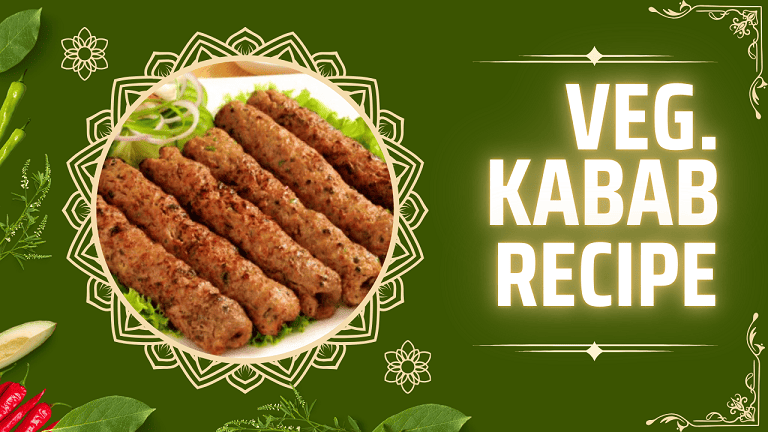Rava Vada Recipe
Rava Vada, also known as Sooji Vada or Semolina Vada, is a crispy, savory snack that hails from South India. Made from semolina (rava or sooji) instead of the traditional urad dal used in medu vada, this dish is quick and easy to prepare, while still being a delicious and nutritious option.
Rava vadas are often served during tea time, as an appetizer, or as part of a festive spread. They offer a delightful contrast of textures—crispy on the outside and soft on the inside—and can be paired with a variety of chutneys or sambar.
The beauty of Rava Vada lies in its versatility. It can be made with readily available ingredients that are common across India, such as semolina, fresh herbs, and spices.
Additionally, the dish is quite adaptable and can be enhanced with various vegetables, making it an even more nutritious option for those looking to incorporate more plant-based foods into their diet.
Health Benefits of Rava Vada
Rich in Carbohydrates: Semolina (rava) is a great source of energy due to its high carbohydrate content. It provides a slow release of energy, making it ideal for keeping you satiated and energetic throughout the day.
Low in Fat: Unlike other deep-fried snacks, Rava Vada can be made with minimal oil when shallow-fried or cooked in an air fryer. This makes it a lighter, healthier option while still retaining its delicious crispiness.
Customizable with Vegetables: You can add a variety of locally available, seasonal vegetables like carrots, onions, or bell peppers to the batter, enhancing the nutritional value with extra fiber, vitamins, and minerals.
Easy to Digest: Semolina is relatively easy on the stomach, making Rava Vada a light snack that’s suitable for all ages.
Quick Fermentation Process: Unlike other vada recipes that require fermentation overnight, Rava Vada is quick and does not need lengthy preparation, which is perfect for those looking for a last-minute snack option.
Ingredients for Rava Vada
For the Rava Vada Batter:
- Rava (semolina) – 1 cup (200g)
- Yogurt (curd) – ½ cup (120g)
- Water – ½ cup (adjust as needed)
- Onion – 1 medium, finely chopped
- Green chilies – 2, finely chopped
- Ginger – 1-inch piece, grated
- Coriander leaves – 2 tablespoons, finely chopped
- Curry leaves – 8-10, finely chopped
- Black peppercorns – 1 teaspoon, crushed
- Cumin seeds – ½ teaspoon
- Baking soda – ¼ teaspoon (optional, for extra fluffiness)
- Salt – To taste
- Oil – For frying (use coconut oil or vegetable oil)
Optional Add-ins:
- Grated carrots – ¼ cup (for added nutrition)
- Finely chopped spinach – ¼ cup (for a boost of iron and fiber)
- Grated coconut – 1 tablespoon (for additional flavor and texture)
Step-by-Step Instructions
Prepare the Batter:
Mix Semolina and Yogurt: In a large mixing bowl, combine the semolina and yogurt. Mix well to form a thick batter. The yogurt helps soften the semolina and adds a tangy flavor to the vada. If the batter seems too thick, add a little water, one tablespoon at a time, until you achieve a smooth consistency. Let the batter rest for about 15-20 minutes, allowing the semolina to absorb the moisture and swell.
Add Vegetables and Spices: After resting the batter, add the chopped onions, green chilies, grated ginger, coriander leaves, curry leaves, black peppercorns, and cumin seeds. If you’re adding grated carrots, spinach, or grated coconut, mix them into the batter at this stage. Season with salt and stir everything together until well combined. If the batter seems too thick after adding the vegetables, you can add a little more water to loosen it.
Add Baking Soda (Optional): For extra fluffiness, you can add a pinch of baking soda to the batter. This will help the vada puff up when fried, giving it a lighter texture. Stir well to incorporate.
Shape the Vadas:
Wet your hands lightly with water to prevent the batter from sticking. Take a small portion of the batter (about the size of a golf ball) and roll it into a smooth ball. Flatten it slightly with your palms, then use your thumb to make a small hole in the center, giving the vada its characteristic doughnut shape. Repeat the process for the remaining batter.
Fry the Vadas:
Heat the Oil: In a deep frying pan or wok, heat oil over medium heat. To test if the oil is hot enough, drop a small piece of batter into the oil. If it sizzles and rises to the surface, the oil is ready for frying.
Fry the Vadas: Carefully slide 3-4 vadas into the hot oil, ensuring that you don’t overcrowd the pan. Fry them on medium heat for 3-4 minutes on each side, or until they turn golden brown and crispy. Use a slotted spoon to flip the vadas halfway through to ensure even cooking on both sides.
Drain Excess Oil: Once the vadas are crispy and golden, remove them from the oil and place them on a plate lined with paper towels to drain any excess oil.
Alternative Cooking Methods (For Healthier Options):
Shallow Frying: For a healthier alternative, you can shallow fry the vadas in a pan with a smaller amount of oil. They will still turn crispy but with less oil absorbed.
Air Frying: If you have an air fryer, you can cook the vadas at 180°C (350°F) for about 12-15 minutes, flipping them halfway through for even cooking. Brush them with a little oil before air frying for a crispier texture.
Tips for Maximizing Flavor and Nutrition
Use Fresh, Locally Sourced Vegetables: Incorporate seasonal vegetables such as carrots, spinach, or grated beetroot to boost the nutritional value of the dish. Fresh vegetables add natural sweetness, fiber, and essential vitamins, making the dish more balanced and wholesome.
Spices for Digestion: The addition of ginger, cumin, and black pepper not only enhances the flavor but also aids in digestion. These spices stimulate digestive enzymes, making the dish easier on the stomach.
Use Healthy Oils: Opt for coconut oil or cold-pressed vegetable oils for frying to retain the nutritional integrity of the vadas. Coconut oil is rich in healthy fats and adds a subtle, aromatic flavor to the vadas.
Control the Heat: Fry the vadas on medium heat to ensure they cook evenly. Frying them on high heat may cause the outside to brown too quickly, leaving the inside undercooked.
Balanced Texture: Resting the batter is essential to ensure that the semolina absorbs moisture, which helps the vadas maintain their shape while frying. This step ensures that the vadas are soft inside but crispy outside.
Variations and Substitutions
Gluten-Free Version: To make Rava Vada gluten-free, you can substitute semolina with a gluten-free option like rice flour or millet flour. The vadas may have a slightly different texture, but they will still be crispy and flavorful.
Vegan Version: Rava Vada is naturally vegetarian, but to make it vegan, replace the yogurt with a plant-based alternative such as coconut yogurt or cashew yogurt. These substitutes will still provide the tanginess needed to balance the flavors.
Spice Level: Adjust the number of green chilies and black peppercorns based on your spice tolerance. You can also add a pinch of red chili powder for extra heat or skip the chilies altogether for a milder flavor.
Protein Boost: Add soaked and finely chopped nuts such as almonds or cashews to the batter for a protein boost and a delightful crunch in every bite.
Herb Variation: You can experiment with different herbs like mint or dill instead of coriander leaves for a unique flavor profile.
Serving Suggestions and Presentation
With Chutneys: Serve the hot, crispy Rava Vadas with a variety of chutneys, such as coconut chutney, tomato chutney, or mint chutney. The combination of the spicy, tangy chutneys with the savory vada makes for a delightful contrast in flavors.
With Sambar: For a more substantial meal, pair the Rava Vadas with a bowl of steaming hot sambar. The soft, spongy texture of the vada soaks up the flavorful sambar, creating a wholesome and satisfying dish.
As a Snack Platter: Rava Vadas can be part of a larger snack platter, served alongside other South Indian favorites like medu vada, idli, or mini dosas. This makes for a great party appetizer or festive snack spread.
With Tea or Coffee: Rava Vadas are often enjoyed with a cup of hot tea or filter coffee, making them an ideal snack for the late afternoon or evening.
Presentation Tips
Garnish with Fresh Herbs: Sprinkle the Rava Vadas with freshly chopped coriander or mint leaves just before serving. This adds a pop of color and freshness to the dish, elevating the overall presentation.
Serve on a Banana Leaf: For an authentic South Indian touch, serve the Rava Vadas on fresh banana leaves. This not only adds to the visual appeal but also imparts a subtle aroma to the food, enhancing the dining experience.
Use Earthenware or Traditional Steel Plates: To maintain the traditional vibe, serve the vadas on a thali or in rustic earthenware dishes. Pair them with small bowls of chutney or sambar placed neatly on the side. The earthy presentation style complements the flavors and origins of the dish.
Creative Plating: Arrange the Rava Vadas in a circle on the plate, with a small bowl of chutney or sambar in the middle. Garnish with a few curry leaves or a wedge of lemon for a vibrant and appealing look.
Conclusion
Rava Vada is a delightful and nutritious snack that brings together the simplicity of semolina and the robust flavors of Indian spices and herbs.
Its versatility allows for countless variations, making it suitable for all types of dietary preferences—whether vegan, gluten-free, or packed with added vegetables for extra nutrition.
By using locally sourced ingredients that are fresh and in season, you can maximize the flavor and nutritional content of the dish. The addition of vegetables, spices, and herbs not only enhances the taste but also makes this dish a wholesome option for both children and adults.
Whether you’re serving Rava Vada as a quick snack, an appetizer at a festive gathering, or alongside sambar and chutney for a more substantial meal, this dish is sure to be a crowd-pleaser. The crispy, golden exterior and the soft, flavorful interior make every bite an experience in itself.
So, the next time you’re in the mood for something crispy, savory, and satisfying, reach for the ingredients to make Rava Vada. With minimal effort and maximum flavor, it’s a dish that truly embodies the joy of Indian vegetarian cuisine.
Thanks for visiting Veg Recipe

